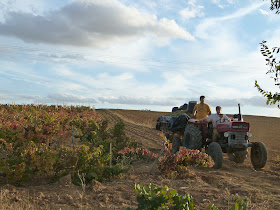Sunday, 14 October 2012
Bones in the Vineyard
Their bitter skins stretch tight over their sweet, seedy hearts. They are Jerez grapes, they hang in great bunches from the last lines of vines atop Segundino´s vineyard.
Yesterday a great mob of Segundino´s kin gathered from far and wide. They came to snip and trim and load and ladle grapes off the vine and into tubs, off the tubs and into the tractor-bed, off the hillside and down into town and up to the open door of the winepress, then trundled into the newly-tiled vat in the funky dark where wine is born.
I told you before about this family, how only two of the brothers live here full-time, but how their nine brothers and sisters, their spouses and offspring, in-laws and cousins, schedule their lives around the rural rites of vine-cutting, pig-butchering, tree-cutting, bodega-building.
And when I rolled up on my bike at the vineyard on Friday, they said Sure I could help them with the Vendimia. They needed all the help they could get! And so I was paired with Alberto, Angeles´ 30-something firstborn, an amateur archaeologist who lives in Pamplona. Our hands were busy with the snipping and tucking, and we moved fast along the vines as we talked -- or he talked, mostly. I tried my best to keep up. We talked about Moratinos, local history and culture, what´s been lost since he was a boy here in town, what´s changed for the better. We talked about the Camino -- he walked it in the 1980s, and again not so long ago.
Now and then someone burst into song.
We talked about bones. When he was a boy, Alberto and some other kids found human bones sticking out of the ground right there on the Camino, where the bank had washed out. They loaded them into a big trash bag and took them home. Maybe it was then he decided to study archaeology, he mused.
I asked about those bones. How old might they have been? Could there be a civil war fossa here, a roadside ditch where civilian victims were buried?
No one from Moratinos went missing during the Civil War, he said. And these bones were clean. Old. The bones found around here go too far back for anyone to remember...Skulls have turned up in the Rio Templarios for time out of mind. Plows uncover tibias and jawbones. People have lived and died here for a thousand years or more, and the clay soil is preservative. When you die it takes a long time to turn to dust.
I told him about Americans´ sense of history, how a building only 200 years old is jealously preserved, considered a landmark -- unless it gets in the way of a parking lot project. Nothing is very old in America. We come from so many places, and the land is so big and wide, we don´t share a lot of common culture. We are individualists. So we honor our family roots. Children compare their ethnic pedigrees: "I´m Russian on my dad´s side, and Scottish on my mom´s." The more mix you had, but more colorful you were... and how chichi it was to have a forebear who was "full-blooded Cherokee!"
He smiled at that. "All of us here?" he said, waving his clippers at Judit and Angel, Sara and Hilario, "every one of us is full-blooded Moratinos. Castilian. Nada mas."
"Purebreds," I said.
We clipped and snipped. He held up a long branch so I could pull the bunches of fruit from underneath.
"The bones you found," I said. "That person might have been one of your ancestors. What happened to the bones? Did you take them to the cemetery to bury?"
Alberto just shrugged. "Why? No one knows anything about whose bones they were. They are bones. They aren´t a person any more."
I gnawed on that for a while. We are sentimental, us Americans and English -- squeamish, morbid, maybe a little paranoid. If my kid found a cranium, I´d scream first, then call the police.
But old bones, along a path in central Spain... whose innards ended up in Alberto´s trash bag? Were they male or female, Arab, Christian, Jewish, or even Celt? There´s a paleolithic burial mound a half-mile from the vineyard. There´s a Roman villa nine kilometers east, and a big medieval monastic complex nine kilometers west. Soldiers criss-crossed this countryside, Templar knights, Al-Mansour´s Moorish raiders, French and English fighting over the peninsula. And centuries of farmers, pilgrims, and ordinary Marias and Josés lived here. Their bones had to go someplace when they were finished using them.
I looked at the gravelly soil underfoot, and wondered if anybody was under there, pushing up the grapevines. I laughed at myself, marveled at how centered we humans are on humans -- any bones beneath me could just as well have belong to deer or pigs, dogs or quail, owls or hares or Permian fish, fossilized.
We start as dust, we end as dust. Or bones. We are only us for such a little while.
Smart people make wine while they can. With their families.





As the American band The Cars would say, "Let the good times roll."
ReplyDeleteand how much richer is the soil and their lives for all of those "bones"
ReplyDeletelove, k
Lovely pictures and post. This made me smile: "Every one of us is full-blooded Moratinos. Castilian. Nada mas."
ReplyDeleteProblem is... what does it mean to be a Castilian?
"Family trees" are not trees at all, their branches join inevitably at some previous generation. So, even people from Moratinos descend from practically anybody who lived on the Iberian peninsula, let's say, 2000 years ago, and from many who lived 1000 years ago. Inevitably...
Saludos
Tino (Galician mutt, whatever that means).